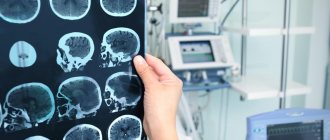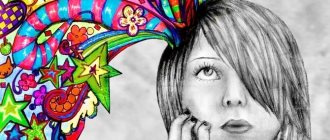Alice in Wonderland syndrome is a rare neurological sensory disorder. It is characterized by distortions of visual perception (metamorphopsia) of one’s body or its individual parts, a violation of the “body diagram”: when the entire body or its individual parts are perceived by the patient as larger (macrosomatognosia) or as smaller (microsomatagnosia). The disease may also be accompanied by disorientation in time, derealization or depersonalization. In other words, it represents the presence of an imbalance in the patient between self-image and/or perception of the real world.
Historical perspective
Alice in Wonderland syndrome was first coined and described in 1955 by British psychiatrist John Todd (1914-1987) to define a group of symptoms “...closely associated with, but not limited to, migraine and epilepsy.”
Alice syndrome
He also included illusory changes in the size, distance or position of stationary objects in the visual field, illusory feelings of levitation, or illusory changes in the sense of time. The name of the disease refers to the well-known children's book by Lewis Carroll, “Alice's Adventures in Wonderland,” in which the main character ⎼ Alice felt her body either growing or, on the contrary, becoming smaller.
By the way, Todd was well aware that he was not the first to describe these individual symptoms. Many of them have already appeared in the literature on hysteria and general neurology. For example, one of the scientists involved in the study of this syndrome, Lippman, was also the first to suggest that feelings of physical changes in one's body, akin to those experienced by Alice in the book of the same name, may well be inspired by those “body schema” illusions. which Lewis Carroll himself once experienced.
Carroll (the pseudonym of the British mathematician Charles Lutwidge Dodgson, 1832–1898) famously suffered from migraines, and his diaries indicate that his attacks were sometimes preceded by auditory phenomena and hallucinations. However, historians consider Lippmann's hypothesis unconvincing since the diaries fail to demonstrate that Dodgson experienced any auditory phenomena before he wrote his book. An alternative hypothesis is that Dodgson knew or may have experimented with the hallucinogenic mushroom Amanita muscaria (red fly agaric).
Whatever the exact course of events, with Alice in Wonderland Dodgson created a character that appealed to doctors as much as it did to the book's target audience. And John Todd very aptly chose a well-known name for a group of symptoms that have hitherto been described separately from each other. Only after 60 years of relative obscurity did this mental disorder begin to receive scientific attention. This renewed interest is due in part to the current opportunity to explore the brain networks responsible for mediating its symptoms using functional imaging techniques.
Alice in Wonderland Symptoms
The symptoms of this disease have both diagnostic and therapeutic implications that differ significantly from those in schizophrenia spectrum disorders and other hallucinatory syndromes. Thus, over the past 60 years, the symptoms of this mental disorder have grown to include 42 visual symptoms and 16 somatic and other non-visual symptoms. What these symptoms have in common with each other is that they represent distortions of sensory perception rather than hallucinations or illusions.
Hallucinations are perceptions experienced in the absence of a corresponding stimulus from the outside world, such as a voice heard in complete silence or seeing an image of a cat that is not there. Illusions have a source in the external world, albeit one that is (often fleetingly) misinterpreted or misinterpreted. Thus, music can be heard in a walking, passing stream, and a curtain moving in the wind can be mistaken for an intruder.
Like illusions, distortions are based on sensory impressions, but they are characterized by highly idiosyncratic changes in very specific aspects of the sensory input pattern. For example, all straight lines may be perceived as wavy (dysmorphopsia), all vertical lines as horizontal (plagiopsia), all stationary objects as moving (kinetopsia), and the eyes of people or animals may be perceived as unnaturally large (prosopometamorphopsia).
But at the same time, micropsia (when various objects are perceived by the patient as smaller in size than they actually are) and macropsia (the same as micropsia, only vice versa) were described most often in the literature (in 58.6% and 45.0 % of all patients, respectively), which may indicate that they are the most common types of distortions, but also that they are the most well-known and therefore the most studied.
The duration of symptoms of this disease is usually short. Episodes may occur several times during the day and last less than 24 hours. However, in some cases the disease can be chronic and symptoms can persist for several years or even a lifetime.
An important detail is also that after visual fixation on an object, visual distortions (metamorphopsia) can sometimes occur at certain intervals: from several seconds to minutes.
After this time delay, objects are perceived in a distorted way, but during the delay the process of perception is not disrupted. In the psychiatric literature, this phenomenon is explained as a sign of cerebral asthenopia (that is, unusual fatigue of the perceptual system).
Features of the flow
The patient's condition worsens in episodes. One attack of distorted perception lasts from 5-15 seconds to 2-3 minutes. Rarely - up to 30 minutes.
There are four types of distortions (forms of the syndrome):
- macropsia - the illusion of expansion of the body and surrounding objects;
- micropsia – the illusion of narrowing and reduction of the body and surrounding objects;
- pelopsia – perception of distant objects as close;
- teleopsia - the perception of close objects as distant.
Prevalence of the disease
In general, there are no statistical data on the prevalence of Alice in Wonderland syndrome among the world's population. Since 1955, no more than 169 case reports have been published. Although it is generally assumed that the disease is quite rare, clinical studies among migraine patients suggest that the prevalence rate in this group may be around 15%. The scientific literature indicates that this may be just the tip of the iceberg.
Moreover, according to the information received, many of the individual symptoms of Alice in Wonderland syndrome are experienced (albeit sometimes only fleetingly) by up to 30% of children and adolescents in the general population.
Typically, this syndrome may be present in early childhood and is considered a precursor to migraine. Despite the fact that children and adolescents are more susceptible to this disease, this does not exclude the possibility of clinical cases of Alice in Wonderland syndrome occurring in adults.
The results of a study by Smith et al, which included 16 children aged 8 to 18 years, showed that the average age of onset of visual changes was about 8.4 years, while headache attacks began at about 9.4 years. In 4 children, the onset of visual symptoms was identified before the onset of the headache, and in 2 children, visual symptoms began simultaneously with the headache episode, and finally, in 3 other children, visual symptoms appeared after the headache ended.
One study also found that the lifetime prevalence of micropsia and/or macropsia was 5.6% for men and 6.2% for women. A second cross-sectional study of 3224 high school students found the 6-month prevalence to be 3.8% for micropsia, 3.9% for macropsia.
A third cross-sectional study of 297 people with a mean age of 25.7 years found a lifetime prevalence of 30.3% for teleopsia (where objects are perceived as being further away than they really are and the perception of depth is usually exaggerated), 18.5% for dysmorphopsia, 15.1% for macropsia and 14.1% for micropsia. This study also showed that 38.9% of victims had one symptom, 33.6% had 2, 10.6% had 3, and 16.8% had 4.
This accumulation may indicate a common etiological process responsible for mediating all 4 symptoms or a random process in which the presence of one symptom lowers the threshold for the addition of another.
However, these statistics are believed to be incomplete and represent only a small part of the actual prevalence of the syndrome, mainly due to the lack of definition, classification and adequate diagnostic criteria that are consistent with international parameters, in addition to the lack of reliable epidemiological data considering its real size.
Links[edit]
- Longmore M, Wilkinson I, Turmezei T, Cheng CK (2007). Oxford Handbook of Clinical Medicine
. Oxford. item 686. ISBN. 978-0-19-856837-7. - "Alice and Wonderland Syndrome and Visual Migraine".
- “Alice in Wonderland Syndrome | Symptoms and treatment". Share.upmc.com. 2016-10-25. Retrieved August 30, 2021.
- Cinbis M, Aysun S (May 1992). "Alice in Wonderland syndrome as an initial manifestation of Epstein-Barr virus infection". Br J Ophthalmol
.
76
(5): 314. DOI: 10.1136/bjo.76.5.316. PMC 504267. PMID 1390519. - ^ a b
Feldman, Caroline (April 7, 2008).
"Not a Very Nice Tale: A Study of Alice in Wonderland Syndrome". Serendip
. Serendip Studio, Bryn Mawr College. Archived from the original on November 9, 2008. Retrieved November 25, 2011. - ^ a b
Eshel, Lahat (1991).
"Alice in Wonderland syndrome: a manifestation of infectious mononucleosis in children." Behavioral Neuroscience
.
4
(3): 163–166. DOI: 10.3233/BEN-1991-4304. PMID 24487499. - Stapinski H (23 June 2014). "I had Alice in Wonderland syndrome". New York Times
. Archived from the original on September 6, 2015. - ^ a b c d e
O'Toole P., Modestino E.J.
(June 2021). "Alice in Wonderland Syndrome: A Real-Life Version of Lewis Carroll's Novel." Brain and Development
.
39
(6):470–474. DOI: 10.1016/j.braindev.2017.01.004. PMID 28189272. - ^ B s d e g
Faruk O, Chistovaya
E.Yu. (December 2021). "Alice in Wonderland Syndrome: A Historical and Medical Review." Child Neurology
.
77
: 5–11. DOI: 10.1016/j.pediatrneurol.2017.08.008. PMID 29074056. - Craighead WE, Nemeroff CB, eds. (2004). "Hallucinations." Corsini's Concise Encyclopedia of Psychology and Behavioral Science
. Hoboken: Wiley. ISBN 978-0-471-22036-7. - "Alice in Wonderland Syndrome." Mosby's Dictionary of Medicine, Nursing, and Health Professions
. Philadelphia: Elsevier Health Sciences. 2009. ISBN. 978-0-323-22205-1. - "Micropsia". Mosby's Dictionary of Emergencies
. Philadelphia: Elsevier Health Sciences. 1998 - "Macropsia". Collins English Dictionary
. London: Collins. 2000. ISBN 978-0-00-752274-3. Archived from the original on January 7, 2021. - Hamed SA (January 2010). "A variant of migraine with abdominal colic and Alice in Wonderland syndrome: a report and review". BMC Neurology
.
10
: 2. doi: 10.1186 / 1471-2377-10-2. PMC 2817660. PMID 20053267. - ^ a b
Lanska JR, Lanska DJ (March 2013).
"Alice in Wonderland Syndrome: Some kind of aesthetic disorder against visual perception." Neurology
.
80
(13): 1262–4. DOI: 10.1212/WNL.0b013e31828970ae. PMID 23446681. - Ffytche DH (2007-06-07). "Visual hallucinatory syndromes: past, present and future". Dialogues in Clinical Neuroscience
.
9
(2): 173–89. PMC 3181850. PMID 17726916. - Platz WE, Oberlander FA, Seidel ML (1995). "Phenomenology of perceptual hallucinations in alcoholic delirium tremens." Psychopathology
.
28
(5): 247–55. DOI: 10.1159/000284935. PMID 8559948. - "What is Alice in Wonderland Syndrome?" . WebMD
. Retrieved September 6, 2021. - Hemsley R. (2017-09-13). "Alice in Wonderland Syndrome". aiws.info
. Archived from the original on 2017-09-14. Retrieved September 13, 2021. - Farooq O, Fine EJ (December 2021). "Alice in Wonderland Syndrome: A Historical and Medical Review." Child Neurology
.
77
: 5–11. DOI: 10.1016/j.pediatrneurol.2017.08.008. PMID 29074056. - Cinbis M, Aysun S (May 1992). "Alice in Wonderland syndrome as an initial manifestation of Epstein-Barr virus infection". British Journal of Ophthalmology
.
76
(5): 316. DOI: 10.1136/bjo.76.5.316. PMC 504267. PMID 1390519. - "Alice in Wonderland Syndrome." Taber's Cyclopedic Medical Dictionary
. Philadelphia: F. A. Davis Company. 2009. ISBN. 978-0-8036-2325-5. - ^ a b c
Mastria G, Mancini V, Vigano A, Di Piero V (2016).
"Alice in Wonderland syndrome: a clinical and pathophysiological review". BioMed Research International
.
2016
: 8243145. doi: 10.1155/2016/8243145. PMC 5223006. PMID 28116304. - Kuo YT, Chiu NC, Shen EY, Ho CS, Wu MC (August 1998). "Cerebral perfusion in children with Alice in Wonderland syndrome." Child Neurology
.
19
(2): 105–8. DOI: 10.1016/s0887-8994(98)00037-X. PMID 9744628. - Stapinski, H (24 June 2014). "I had Alice in Wonderland syndrome". New York Times
. Retrieved July 7, 2021. - O'Toole P, Modestino EJ (June 2017). "Alice in Wonderland Syndrome: A Real-Life Version of Lewis Carroll's Novel." Brain and Development
.
39
(6):470–474. DOI: 10.1016/j.braindev.2017.01.004. PMID 28189272. - O'Toole P, Modestino EJ (June 2017). "Alice in Wonderland Syndrome: A Real-Life Version of Lewis Carroll's Novel." Brain and Development
.
39
(6):470–474. DOI: 10.1016/j.braindev.2017.01.004. PMID 28189272. - Farooq O, Fine EJ (December 2021). "Alice in Wonderland Syndrome: A Historical and Medical Review." Child Neurology
.
77
: 5–11. DOI: 10.1016/j.pediatrneurol.2017.08.008. PMID 29074056. - O'Toole P, Modestino EJ (June 2017). "Alice in Wonderland Syndrome: A Real-Life Version of Lewis Carroll's Novel." Brain and Development
.
39
(6):470–474. DOI: 10.1016/j.braindev.2017.01.004. PMID 28189272. - Abe K, ODA N, Araki R, Igata M (July 1989). "Macropsia, micropsia, and episodic illusions in Japanese adolescents." Journal of the American Academy of Child and Adolescent Psychiatry
.
28
(4): 493–6. DOI: 10.1097/00004583-198907000-00004. PMID 2788641. - Weissenstein A, Luchter E, Bittmann M.A. (2014). "Alice in Wonderland syndrome: a rare neurological presentation on microscopy in a 6-year-old child". Journal of Child Neurology
.
9
(3): 303–4. DOI: 10.4103/1817-1745.147612. PMC 4302569. PMID 25624952. - Todd J (November 1955). "Alice in Wonderland Syndrome". Journal of the Canadian Medical Association
.
73
(9):701–4. PMC 1826192. PMID 13304769. - "Dr. John Todd's career and case studies of drug addiction". Highroydshospital.com. Archived on June 07, 2014. Retrieved June 4, 2014.
- Kau C (October 1999). “La sindrome di Alice nel paese delle meraviglie” [Alice in Wonderland Syndrome]. Minerva Medica
(in Italian).
90
(10): 397–401. PMID 10767914. - Martin R. "Through the Looking Glass, Another Look at Migraine" (PDF). Archived (PDF) from the original on 09/21/2013. Retrieved September 15, 2013.
- Chand PK, Murthy P. "Understanding a strange phenomenon: Lilliputian hallucinations". German Journal of Psychiatry
. Archived from the original on 2009-01-23. Retrieved October 25, 2009. - "Medical Definition of Lilliputian Hallucination". MedicineNet
. Retrieved August 16, 2021. - Martin R. "Through the Looking Glass, Another Look at Migraine" (PDF). Archived (PDF) from the original on 09/21/2013. Retrieved September 15, 2013.
- Angier N (1993-10-12). "In the temporal lobes, seizures and creativity". New York Times
. ISSN 0362-4331. Archived from the original on September 13, 2021. Retrieved September 13, 2021. - Writer: Lisa McMullin; Director: Daniel Wilson; Producer: Peter Leslie Wild (7 April 2021). "Al through the Looking Glass". The doctors
. BBC. BBC One.
Pathophysiology of the disease
Symptoms are associated with functional and structural abnormalities in the perceptual system. In general, central pathology is considered the most common cause. However, dysmorphopsia (where all straight lines may be perceived as wavy), for example, is also seen in the context of retinal ablation and some other types of eye diseases.
And plagiopsia (visual tilt) is also observed in the context of ataxia or labyrinthine disease - a violation of the coordination of movements of various muscles in the absence of muscle weakness; one of the most commonly observed motor disorders.
However, most symptoms are associated with centrally located populations of neurons and even columns of cells that selectively respond to specific types of sensory input (for vision, especially in cortical areas V1-V5). For example, area V4 of the extrasystatic visual cortex responds selectively to color, whereas area V5 responds to motion. Both regions also respond to shape and depth, but bilateral loss of V4 function results in achromatopsia (inability to see color), and bilateral loss of V5 results in akinetopsia (inability to see movement).
The inability to visually perceive vertical lines (plagiopsy) or lines at other angles is due to the loss of function of the orientation columns, which are grouped along the horizontal layers of the visual cortex.
Psychiatrists Lerner and Lev-Ran described in a patient report a 26-year-old patient who, during LSD intoxication, had episodes of visual illusions in the form of macropsia, micropsia, pelopsia and teleopsia. These distortions occurred when the subject observed moving objects, stationary objects, people, and inert objects. Even though this person stopped using LSD, the optical illusions persisted.
The patient refused pharmacological treatment, but continued follow-up visits to the psychiatrist. After which, over the course of a year, his visual distortions gradually began to disappear.
Diagnosis of Alice in Wonderland syndrome
This syndrome is not included in major classifications such as ICD-10 (or International Statistical Classification of Diseases and Related Health Problems, Tenth Revision - ICD-10) and DSM-5 (Diagnostic and Statistical Manual of Mental Disorders, 5th Edition).
As a consequence, in clinical practice, a diagnosis of Alice in Wonderland Syndrome is made only with a proper history, a thorough physical (including neurological, often otological and/or ophthalmological) examination and reliable knowledge of the many and varied symptoms characteristic of this mental disorder. and possible reasons for its occurrence.
The symptoms of this syndrome should be distinguished from other positive perceptual disorders, such as hallucinations and illusions, with which they can easily be confused. If the condition is suspected, additional tests may also be performed, including blood tests, EEG and MRI of the brain, even if the likelihood of finding any visible damage is usually considered low.
What causes seizures
The study of the problem of how the syndrome arises continues. It is generally accepted that the underlying migraine develops due to the deregulation of tone experienced by the vessels of the brain. Alternate states of hypoxia/hyperoxia occur, caused by the slow dilation of blood vessels that occurs after a painful sharp spasm. Disruption of neuronal activity causes hallucinations.
With the development of a migraine aura, areas of the parietal cortex of the brain are affected, usually the visual and somatosensory areas. In this case, the mechanism that integrates incoming sensory data is disrupted, and sensory and tactile sensations are distorted.









